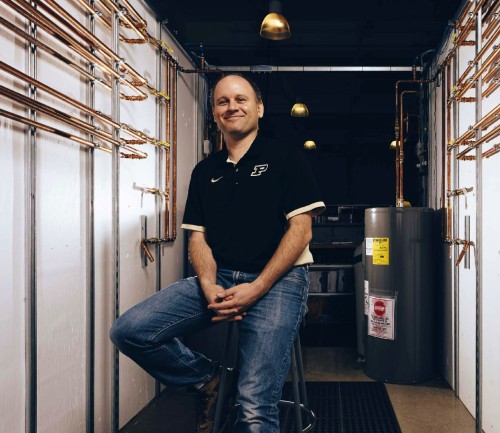Measuring Water Quality at Scale
First-of-its-kind integrated plumbing system replicates real-world conditions
A research team, led by Andrew Whelton, professor of civil engineering and environmental and ecological engineering, wanted to study the safety of drinking water in new homes and buildings. However, conducting these tests in inhabited buildings across the country was impossible — so, Whelton’s team aimed to correct that.
“One of the biggest questions I have had since I started researching water quality is: How does water quality change when you start a new water system?” Whelton said. “If you build 12 replicate new homes, will the water quality be the same in all of them, at every tap? These questions haven’t really been answered before because all the tests before have been done in older buildings or at a much smaller scale.”
Given these questions, Whelton’s team opted instead to construct a large multi-plumbing system in the Burke Hydraulics and Hydrology Research and Teaching Lab in the basement of Hampton Hall. The facility includes four identical walls fitted with real-time online water quality monitoring systems, automatic flushing systems and an online data acquisition system.
“We constructed the facility to answer questions at scale,” Whelton said. “There’s nothing else like this. And, with this capability, we can now gain a greater understanding about how water quality changes in building plumbing.”

Professor Andrew Whelton prepares to gather samples with (from left) Purdue Civil Engineering undergraduate Laura Gustafson, Environmental and Ecological Engineering PhD student Aliya Ehde, and Environmental and Ecological Engineering master’s student Caroline Jankowski.
Whelton said at-scale plumbing testing is something that has been sorely needed and he is excited to be able to conduct research that could result in a dramatic discovery with drinking water health and safety.
More than 20 undergraduate and graduate students over the past three years helped to build everything from constructing the walls to joining pipes to wiring and calibrating electronic monitoring equipment. William Schmidt, an engineering technician, was instrumental in training and supervising the student crew. Whelton learned a lot from Schmidt, too, he said.
“Plumbing is critical to the health, security and viability of the nation,” Whelton said. “Here at Purdue, we are working on understanding how to better design buildings; how building plumbing affects water safety so we can make advancements to improve human health and well-being in the nation.”

Environmental and Ecological Engineering PhD student Aliya Ehde (left) and Civil Engineering master’s student Maria Palmegiani review the collected water samples.
Lauren Gustafson, a civil engineering undergraduate researcher, said both the ongoing research and the efforts made to even achieve such results have been eye-opening.
“This is just one of those things where you assume that there must be some facility out there already for testing like this, but there wasn’t — and there’s such a great need for research at this scale to be conducted,” Gustafson said. “Water — especially in our homes — is critical to our health and safety.”
Starting in the fall of 2021, Whelton’s team took to studying the effects of water softeners on plumbing systems. In the initial months of operation, Whelton said his team discovered that there are significant changes to building water safety in plumbing that is designed and operated in the exact same way and receive water from the exact same source.
“What we’re looking at now is the degree new water softeners leach chemicals into drinking water,” Whelton said. “There are tens of millions of water softener systems installed nationwide. These remove hardness or minerals from water but nobody has really reported on the types of chemicals they impart to the water.”
Whelton said his team’s focus is on the plastic resin beads within water softeners and the plastic components that help transport water through the device. Now that the team has identified leaching as a problem, they are working to determine the health concerns these chemicals may pose.
“Ultimately, what we hope to gain from our work is to finally answer the question we all have,” Whelton said. “Whether it’s turning on the tap, starting the washing machine or walking up to a water fountain, we all want to know: Is this water safe?”

Future Research
One of the greatest assets to the new facility, Whelton said, is that it affords his team and collaborators the opportunity to research many more issues facing water quality. In the coming months, Whelton said his collaborator Caitlin Proctor, professor of agricultural and biological engineering and environmental and ecological engineering, aims to also study the effects sitting water has on water quality.
“Globally, there are excellent researchers who have been studying how water quality changes when it’s left to set for a while, but there’s no real way to test these in real-time atscale,” Whelton said. “People go on vacations or just go away for the weekend — but, when they come back, how much has the water changed? Are there legitimate health and safety risks? That’s what my colleague Professor Proctor is now exploring at the facility.”
Whelton and Proctor are director and associate director of the Health Plumbing Consortium, a group of leading plumbing companies. More information about this work can be found at www.PlumbingSafety.org
